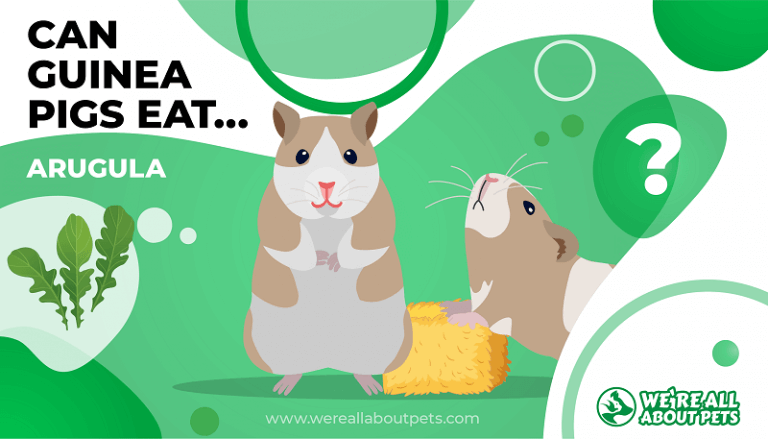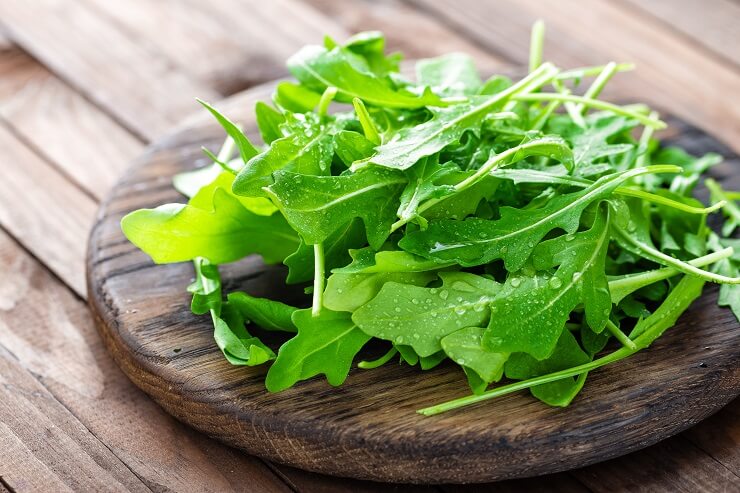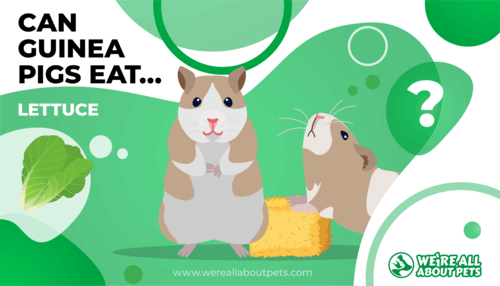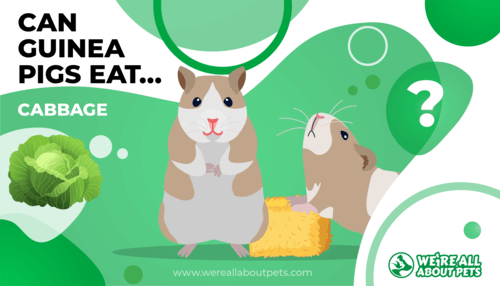Can Guinea Pigs Eat Arugula?
This page contains affiliate links. We may earn money or products from the companies mentioned in this post through our independently chosen links, which earn us a commission. Learn More

Thanks to its zesty flavor, arugula is a popular salad green. It adds tons of interest to meals while providing a powerful nutritional punch.
If you happen to have this yummy veggie on hand, you’re probably wondering if it’s okay to share with your pet. Can guinea pigs have arugula? If so, how much can they have, and how often?
As it turns out, the answer to your question is yes! Guinea pigs can have arugula – but only in small amounts and not as often as you might think.
Keep on reading, because we are about to tell you everything you ever wanted to know about arugula for guinea pigs.
Arugula Nutrition Stats
Just like other leafy greens, arugula gives you lots of satisfaction without many calories.
A serving of arugula offers approximately:
- 5 calories
- .4 g carbohydrates
- .2 g fiber
- .1 g fat
- .3 g protein
Arugula Nutritional Facts

Even though arugula isn’t a high-calorie food, it’s surprisingly nutritious. A serving of this yummy green gives you about:
- 5 mg vitamin C
- 237 iu vitamin A
- 9 mg potassium
- .1 mg iron
- 7 mcg folate
- 9 mcg vitamin K
- 16 mg calcium
- 7 mg magnesium
- 2 mg phosphorus
Can Guinea Pigs Have Arugula?
Yes! Guinea pigs can have arugula, but you’ll need to limit how much they eat because it is high in calcium.
In addition, you’ll want to make sure to wash each piece of arugula before you give it to your guinea pig.
Is Arugula Good For Guinea Pigs?
Absolutely – guinea pigs need lots of vitamins and minerals, and arugula is a good source. So long as you’re not overdoing it, arugula can be a great addition to your guinea pig’s diet.
Do Guinea Pigs Like Arugula?
Arugula has a strong, spicy taste. Some guinea pigs seem to appreciate it, while others don’t care for it at all. The best way to find out if your guinea pig likes arugula is to offer them a single piece and see how they respond.
How Much Arugula Can A Guinea Pig Eat?

You probably won’t be surprised at our answer. Since guinea pigs need a lot of variety in their diet, they shouldn’t eat too much of a single vegetable and that includes arugula.
Here’s how much arugula to feed a guinea pig:
| Age | Amount |
| Baby guinea pig | None |
| Adult guinea pig | 2 large arugula leaves or 3 small arugula leaves |
Start out by offering your guinea pig a single arugula leaf – preferably a small one. If they eat it, monitor them for about 12 hours just to make sure that they don’t have any unwanted side effects such as bloating, indigestion, or diarrhea.
So long as everything turns out okay, you can gradually increase their serving size until they are eating the full amount of arugula. It’s okay to mix it up with familiar greens after they have tried it for the first time.
How Often Can A Guinea Pig Eat Arugula?
Guinea pigs do need a little bit of calcium in their diet but too much can cause problems including kidney stones and urinary tract sludge. Only give your guinea pig arugula once or twice per week and never on the same day as other foods that are high in calcium.
The Correct Diet Is Important
Guinea pigs don’t need much to round out their daily diet – but it’s vital that they eat all the right things.
In the wild, guinea pigs eat a vast variety of low-growing plants including plenty of grasses and quite a few different types of small plants.
Since a guinea pig’s natural diet is based almost entirely on these items, you’ll want to offer foods with similar nutrients. And since most of us can’t spend hours on end foraging for food for our pets, we mostly rely on fresh hay, preferably Timothy – it’s one of the best hay varieties for guinea pigs.
Besides an unlimited supply of nourishing hay and a handy drinking bottle that’s always filled with clean, fresh water, guinea pigs need:
- Guinea pig pellets fortified with vitamin C (Check the label for serving amount)
- About one cup of fresh vegetables each day, divided into at least two smaller meals if possible
If you’re new to guinea pig guardianship, you might not know that a guinea pig’s teeth are always growing. Be sure to give your pet plenty of things to chew – hay cubes, untreated softwood sticks, and guinea pig toys are ideal.
What Are Other Healthy Alternatives To Arugula In A Guinea Pig’s Diet?

Even though guinea pigs can eat arugula, you won’t be able to feed it to them every day – and this means you need some additional choices to round out your cavy’s diet!
As it turns out, there are plenty options. Here’s list of guinea pig-approved favorites to help you plan your pet’s meals and snacks:
- green beans
- artichoke
- parsley
- basil
- beets
- beet tops
- cilantro
- carrot
- carrot tops
- romaine
- mint
- swiss chard
- cabbage
- sweet potato
- butter lettuce
- cucumber
- buttercrunch lettuce
- bibb lettuce
- escarole
- rocket
- spinach
- bell pepper
- endive
- parsnip
- zucchini
- summer squash
- pumpkin
- tomato
- bok choy
- asparagus
- yu choy
- broccolini
- broccoli
- brussels sprouts
- cauliflower
- watercress
This is a pretty big list, but the truth is, this world is brimming with a wide array of colorful fruits, veggies, and herbs that are perfectly safe for your guinea pig. Many of them are probably on your own menu!
For now, why not give your guinea pig arugula and see how they like it?
Remember, this is a food that some cavies enjoy, and that others turn their noses up at – we’re curious to find out whether your pet liked it or not!
FAQ
Is arugula safe for guinea pigs?
Yes! Just remember to offer the correct amount and be sure to wash your cavy’s share before you hand it over.
Can arugula make my guinea pig sick?
Yes – but it isn’t very likely. By offering your cavy a gradual introduction to arugula and feeding just a small amount at a time, you can avoid potential issues like bloating, tummy aches, and diarrhea.








